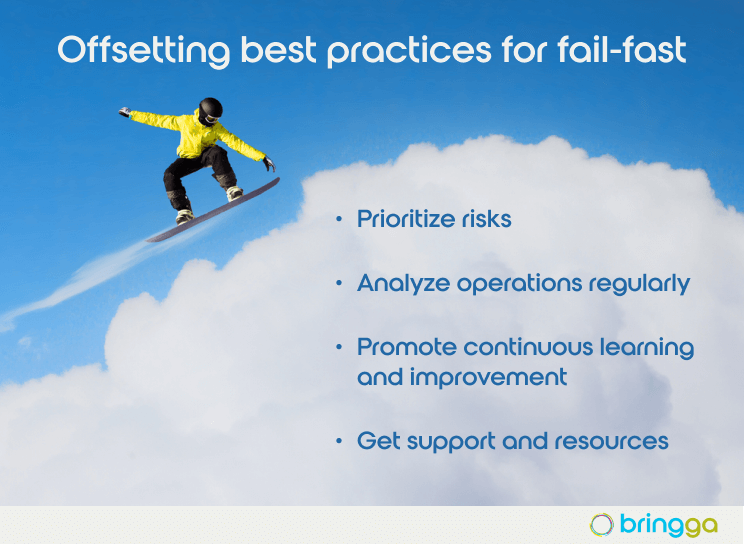A Double-Edged Sword for Startups: Fail-fast

© bringga Content Board| PUBLISHED ON December 25, 2022
The winter months are becoming increasingly apparent as a testing time for startups. In September, we discussed how the venture capital landscape would likely get more brutal, and the prediction has, unfortunately, come true. Startups have been feeling the effects of the cold winter in the venture capital market, as the situation is bleak from all angles.
Similarly, startups face constant challenges and uncertainty in this environment. Startups constantly face challenges that can jeopardize their success, from navigating a difficult market to dealing with unexpected setbacks. To overcome these challenges, startups must develop resilience and perseverance.
Having resilience is the ability to bounce back quickly after setbacks, and having perseverance is the determination to keep going despite obstacles or disappointments. A startup’s long-term success depends on resilience and endurance, which can help startups survive difficult times and emerge stronger and more successful.
The fail-fast approach
Fail-fast criticisms
Of course, some argue that a fail-fast approach is not always the best approach for startups and may even be counterproductive in certain situations. A common criticism of the fail-fast process is that it can lead to a culture of risk-taking and rushed decision-making, as startups feel pressured to break new ground and stay ahead of the competition constantly. This can lead to constant experimentation and failure, which can be costly and draining for the team.
Another potential drawback of the fail-fast approach is that it can discourage long-term thinking and planning. In pursuing quick solutions and rapid iterations, startups may need to pay more attention to the importance of building a solid foundation and laying the groundwork for future success.
However, these criticisms are not necessarily related to the fail-fast approach itself but rather how it is implemented. In moderation and with care, the fail-fast process can be a valuable tool for startups that want to remain flexible and responsive in rapidly changing markets.
Fail-fast’s advantages
One advantage of the fail-fast approach for startups is the ability to identify and solve problems quickly. By actively looking for problems and fixing them early, startups can prevent minor issues from developing into major setbacks. This proactive approach helps companies stay one step ahead of potential problems and allows them to adjust and confidently move forward.
Another advantage of the fail-fast approach is that you can remain flexible and respond to change. Startups often operate in a very dynamic environment, and the ability to adapt quickly to changing market conditions is critical to their success. With a fail-fast approach, startups can quickly identify and address issues so they can pivot and adjust as needed to remain competitive.
Remember, however, that the fail-fast approach may also be premature since it needs to consider the potential impact on all stakeholders. This includes the startup’s founders, employees, investors, and customers. While the fail-fast approach can be a valuable strategy for startups, it is crucial to consider the potential consequences for all stakeholders and take steps to minimize risk and maximize the chances of success.
The potential consequences of the fail-fast approach

While the fail-fast approach can be a valuable strategy for startups, it is essential to consider the potential consequences for everyone involved. This includes the company founders, employees, investors, and customers.
For Founders:
The fail-fast approach can be stressful and exhausting for founders, requiring them to constantly look for problems and quickly search for solutions. This constant pressure to perform and iterate can be mentally and physically exhausting for founders, potentially leading to high-stress levels and burnout.
But the consequences of this approach go beyond the founders’ well-being. When a startup is under constant pressure to refocus and change direction, it can be challenging to build momentum and gain market traction. This can ultimately impact the startup’s chances of success, as it may need help attracting customers, partners, and investors.
The stakes are even higher in the Korean startup ecosystem, where competition is fierce, and capital is often limited. If a startup does not meet investors’ expectations or fails to achieve its goals, it may be difficult for founders to raise money again. This can severely impact the startup’s chances of success, as access to funding is often critical for startups looking to grow and expand.
The fail-fast approach can be an effective way for startups to stay flexible and responsive in a constantly changing environment. But founders should take steps to minimize the impact of this approach on both their well-being and their startup’s success, as well as the potential costs and risks associated with it.
For Employees:
The fail-fast approach can create a fast-paced and uncertain work environment for employees as they may have to adapt to frequent changes and shifts in strategy. This can be especially challenging for employees seeking stability and a sense of purpose in their work, as they may feel uncertain about the direction of the startup and the long-term prospects for their careers.
The constant change and uncertainty associated with the fail-fast approach can negatively impact employee morale and job satisfaction. If employees need to learn what is expected of them or what the future holds for the company, they may feel more motivated and engaged in their work. As a result, they may lose trust in their supervisors and become frustrated or disillusioned with their employers.
In addition, the fail-fast approach can be challenging for employees when committing their time and effort to a specific project or goal. Suppose the company’s direction is constantly changing. In that case, it can be difficult for employees to stay focused and committed to a specific task or project, leading to feelings of aimlessness and disorientation.
In the face of rapidly changing markets, startups can use fail-fast strategies to stay flexible and responsive. Still, leaders must also consider the impact on employees and take steps to make sure they feel supported and engaged in their work.
For Investors:
While potentially beneficial for startups in rapidly changing markets, the fail-fast approach carries a high level of risk for investors. By backing unproven ideas or technologies or weak business models that may not ultimately be successful, investors are taking a calculated gamble with their capital. While it is certainly possible that a startup following the fail-fast approach will achieve success, the chances of failure are also higher than established companies.
The consequences of this approach can be severe for investors, as they may lose confidence in the startup and its leadership if it fails to meet its targets or encounters significant setbacks. In the worst-case scenario, investors may suffer a complete loss of their investment, as the startup may be unable to succeed, and they may lose the millions of dollars they invested.
It is, therefore, crucial for investors to carefully consider the risks associated with the fail-fast approach and to be prepared for the possibility of failure. It is also essential for founders to be transparent with investors about the potential risks and have contingency plans to mitigate them as much as possible. While the fail-fast approach can be an effective way for startups to remain flexible and responsive in rapidly changing markets, all parties must carefully consider the risks and consequences.
For Customers:
The constant evolution of a company’s products and solutions can confuse and frustrate customers. It can create uncertainty about the company’s direction and strategy, leading to a lack of trust in its products and services.
When a company changes its offerings frequently, it may do so in response to changing market conditions or customer needs. Or it may try different approaches to find the most effective solution. While these changes may be necessary for the company’s growth and success, they can also be overwhelming for customers who have already invested time and resources in understanding and using the company’s products or services.
Customers will feel more supported and clearer if a company communicates any changes to its products and solutions. This includes offering training or support materials, providing timely updates and notifications, and being transparent about the reasons for the changes. By taking these steps, a company can restore the trust of its customers, who will feel empowered in their decision to purchase the company’s products or services. Ultimately, companies must strike a balance between the ability to adapt to changing market conditions and customer needs and the ability to support their customers.
Failing fast and balancing best practices

While the fail-fast approach can be a valuable strategy for startups, it is essential to adopt best practices to minimize risk and maximize the chances of success. Some best practices for embracing the fail-fast approach include:
- Prioritizing risks: Startups should identify and prioritize the risks associated with the fail-fast approach and take steps to mitigate those risks. This may involve identifying the potential impacts on all stakeholders and finding ways to minimize those impacts.
- Analyzing operations regularly: Startups should regularly review and analyze their operations to identify areas for improvement and address potential problems. This may involve analyzing data, soliciting feedback from employees and customers, and conducting regular performance reviews.
- Promoting continuous learning and improvement: Startups should promote constant learning and improvement, where failures are viewed as opportunities for learning and growth. This may involve providing training and development opportunities for employees and encouraging a culture of transparency and open communication.
- Getting support and resources: Startups should seek out support and resources to help them navigate the challenges of the fail-fast approach. This may involve working with mentors, advisors, or industry experts to get guidance and support.
- Identifying and implementing more effective solutions: Startups should proactively seek and implement more effective solutions to address problems and improve their operations. This may involve revising their business model, adjusting their products or services, or adopting new technologies. By actively seeking better solutions, startups can continuously improve their operations and increase their chances of success.
By following these best practices, startups can effectively embrace the fail-fast approach and increase their chances of success in a rapidly evolving market.
Conclusion
In sum, while the fail-fast approach can be a valuable strategy for startups, it is essential to fully understand the potential consequences for all stakeholders and take steps to minimize risk and maximize the chances of success. The fail-fast approach carries a high level of risk, and if not properly managed, it can have severe consequences for founders, employees, investors and customers.
For founders, the fail-fast approach can be stressful and exhausting, leading to high stress and burnout that can ultimately impact the startup’s success. For employees, the fast-paced and uncertain work environment can create uncertainty and insecurity, leading to a loss of motivation and engagement. For investors, the risk of backing an idea to an unproven product market fit or go-to strategy can lead to a complete loss of investment if the startup fails or is unable to succeed. For customers, products and solutions that are constantly evolving can confuse and frustrate customers. As a result, customers may need more trust in the company’s products and services as they are uncertain about its direction and strategy.
In short, startups can minimize these risks and maximize their chances of success by identifying and prioritizing risks, conducting regular reviews and analyses, encouraging a culture of continuous improvement, obtaining support and resources, and finding and implementing more effective solutions proactively. By embracing the fail-fast approach and adopting these best practices, startups can increase their chances of success and build resilience and persistence for the long term. Good luck!

